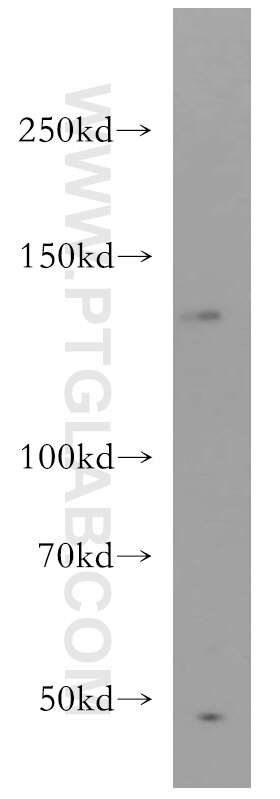BAI3-Specific Polyclonal antibody
BAI3-Specific Polyclonal Antibody for WB, ELISA
Host / Isotype
Rabbit / IgG
Reactivity
human, mouse, rat
Applications
WB, IF, ELISA
Conjugate
Unconjugated
Cat no : 19789-1-AP
Synonyms
Validation Data Gallery
Tested Applications
| Positive WB detected in | HEK-293 cells, Jurkat cells |
Recommended dilution
| Application | Dilution |
|---|---|
| Western Blot (WB) | WB : 1:500-1:1000 |
| It is recommended that this reagent should be titrated in each testing system to obtain optimal results. | |
| Sample-dependent, Check data in validation data gallery. | |
Published Applications
| WB | See 1 publications below |
| IF | See 1 publications below |
Product Information
19789-1-AP targets BAI3-Specific in WB, IF, ELISA applications and shows reactivity with human, mouse, rat samples.
| Tested Reactivity | human, mouse, rat |
| Cited Reactivity | mouse |
| Host / Isotype | Rabbit / IgG |
| Class | Polyclonal |
| Type | Antibody |
| Immunogen | Peptide 相同性解析による交差性が予測される生物種 |
| Full Name | brain-specific angiogenesis inhibitor 3 |
| Calculated molecular weight | 172 kDa |
| Observed molecular weight | 135-140 kDa |
| GenBank accession number | NM_001704 |
| Gene symbol | BAI3 |
| Gene ID (NCBI) | 577 |
| RRID | AB_10666850 |
| Conjugate | Unconjugated |
| Form | Liquid |
| Purification Method | Antigen affinity purification |
| Storage Buffer | PBS with 0.02% sodium azide and 50% glycerol pH 7.3. |
| Storage Conditions | Store at -20°C. Stable for one year after shipment. Aliquoting is unnecessary for -20oC storage. |
Background Information
BAI3, also named as KIAA0550, belongs to the G-protein coupled receptor 2 family and LN-TM7 subfamily. BAI3 might be involved in angiogenesis inhibition and suppression of glioblastoma. This antibody is specific to BAI3.
Protocols
| Product Specific Protocols | |
|---|---|
| WB protocol for BAI3-Specific antibody 19789-1-AP | Download protocol |
| Standard Protocols | |
|---|---|
| Click here to view our Standard Protocols |
Publications
| Species | Application | Title |
|---|---|---|
Behav Brain Res miR-142 downregulation alleviates the impairment of spatial learning and memory, reduces the level of apoptosis, and upregulates the expression of pCaMKII and BAI3 in the hippocampus of APP/PS1 transgenic mice. |



